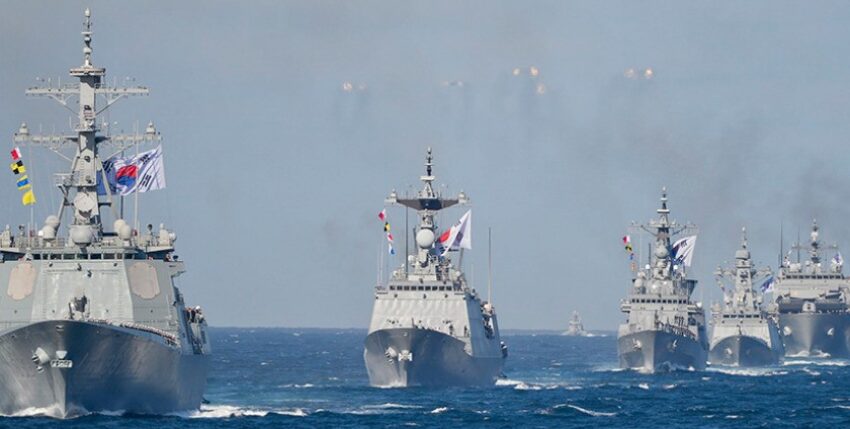South Korea is continuing to work on an ocean-going fleet that can also be used for missions far from home. Aircraft carriers are also on the wish list.
Since the 1950s, the South Korean navy has been focussed on fending off the immediate threat from North Korea. This is currently changing. Seoul is systematically modernising and expanding its fleet. The aim is to create a fully-fledged ocean-going fleet that can also deal with challenges outside its immediate territorial area. On the one hand, this development reflects Seoul's desire to enhance the country's international reputation. In terms of gross domestic product, South Korea now has the tenth strongest economy in the world and the fourth strongest in Asia. A supra-regionally committed security policy proves that Seoul is willing and able to fulfil additional obligations. The desire to gain prestige within Northeast Asia and to be recognised as a fully-fledged partner, especially with regard to Japan, should not be overlooked.
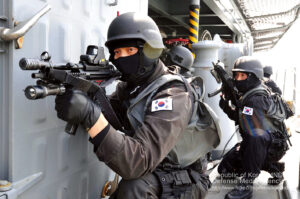
In addition, South Korea's assessment of the long-term security situation in North-East Asia has changed. North Korea remains the primary source of danger. However, other countries - above all China - are also increasingly recognised as a direct future threat. In addition, Seoul wants to be in a position to help shape its own interests in the entire Indo-Pacific region. The country's almost total dependence on maritime trade deepens its determination to protect maritime security and freedom of navigation both within and outside the region.
Even if the new maritime resources are intended to strengthen its ability to conduct independent military operations, Seoul recognises that its national interests are best asserted through cooperation with like-minded partners. In addition to its decades-long close alliance with the US, South Korea is also seeking deeper relations with other regional powers in the Indo-Pacific region, including Australia and India. Cooperation with Japan is also being slowly but steadily expanded, despite ongoing historical resentment. South Korean President Yoon Suk-yeol, who was elected in March 2022, emphasised the strategic necessity of a deeper partnership with Japan even before he took office.
Customised management structure
The goal of acquiring an ocean-going fleet was formally set out in the Korean Navy's twenty-year plan back in 1999. Since then, new, powerful ship classes have been systematically designed and introduced. The aim is to complete the transition to a blue water navy by the mid-twenties.
The 7th Maritime Operations Flotilla was established in February 2010 for the operational command of foreign missions. This proven unit prepares warships for participation in international and multinational operations and takes the lead in unilateral out-of-area operations. As a member of the multinational Task Force 151, the Korean Navy has been continuously involved with a destroyer in the multinational fight against piracy in the Gulf of Aden since 2009. In 2011, Korean special forces on board rescued a chemical tanker hijacked by Somali pirates. Ships from the 7th Flotilla were also ordered to the Mediterranean in 2011 and 2014 to secure the evacuation of South Korean citizens from Libya.

The 7th Flotilla currently has two destroyer squadrons with a total of nine ships and a logistics squadron with fast supply ships. In the medium term, the number of destroyers is to be doubled to 18. And in the long term, a strategic mobile fleet consisting of three operational flotillas is to be created to manage the expeditionary forces.
Fleet modernisation
The South Korean navy currently has around 160 ships. With the exception of the mine warfare vessels and patrol boats, almost all units were introduced after the turn of the millennium. They are considered to be on a par with comparable ships built in China and Japan.
A large part of the current fleet was and is being built by the local companies Hyundai Heavy Industries (HHI) and Daewoo Shipbuilding and Mechanical Engineering (DSME). The current expansion of the fleet affects all ship types. Of particular importance are the destroyers, frigates and submarines.
The South Korean navy currently has nine guided missile destroyers, which are operationally subordinate to the 7th Maritime Task Force Flotilla and fulfil the country's ongoing international obligations. At the same time, the ships are designed to make a significant contribution to defence against North Korean aircraft, cruise missiles, rockets and submarines in the event of war. The main armament consists of Hyunmoo III cruise missiles for engaging land targets, Red Shark K-ASROC missile torpedoes for submarine hunting, SSM-700K Haesong anti-ship missiles and SM-2MR anti-aircraft missiles.
Six units belong to the Chungmugong-Yi-Sun-sin class (DDH II), which was launched in 2003. They displace 5500 tonnes and are equipped with 56 vertical launch silos (VLS). The 11,000 tonne displacement Sejong Daewang class destroyers ("Sejong the Great", KDX III) are the first South Korean warships to be equipped with the Aegis guidance system in the Baseline 7 version. They carry 128 VLS silos and are considered the most powerful combat units in the current fleet. The first tranche, consisting of three ships, was introduced between 2008 and 2012. A second batch consisting of three ships is currently being built. The new units will only displace 8100 tonnes, but will also be able to intercept ballistic missiles. This will be made possible by the interaction of Aegis Baseline 9 in conjunction with SM-3 or SM-6 missiles. The new units will be integrated into the land-based multi-layered South Korean and American missile defence system.
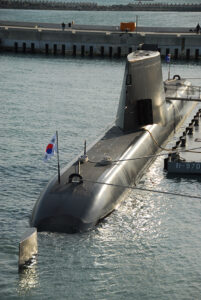
The seventh of eight planned Daegu-class frigates (FFX II) is due to be delivered to the South Korean Navy in November 2023 and is being built by HHI. The ships, which displace 2,800 tonnes, have a range of 4,500 nautical miles and are primarily designed for submarine hunting and air defence. Launched in 2018, the ships are the first South Korean class to have a Codlog (combined diesel-electric or gas) propulsion system. The equipment includes indigenous K-SAAM medium-range anti-aircraft missiles, SSM-700K anti-ship missiles, K-ASROSC, and two sonar systems manufactured by Hanwha Systems for enhanced submarine hunting capability.
The type ship of the latest KSS III class fighter submarine, the Dosan Ahn Chang-ho, was commissioned in 2021. Two more boats from the first batch will follow in 2022 and 2024. At 3400 tonnes, the submarines, which were designed entirely domestically, are almost twice as heavy as their predecessors in the KSS II class, which is based on the German Type 214. The contract for the second of three planned batches was awarded in September 2019, with delivery scheduled for the second half of the twenties. The specified end goal is to procure a total of nine units.
Their range is 10,000 nautical miles. The air-independent propulsion system of the first three units is based on hydrogen-powered fuel cells and enables diving trips of up to 20 days. The armament consists of six 533-millimetre torpedo tubes and six VLS silos with Hyunmoo 4-4 ballistic missiles, which have a range of 500 kilometres. A conventional 1000-kilo class warhead is designed to destroy command bunkers and other hardened underground targets.
The later tranches of the KSS III class will have ten VLS. They will carry ballistic missiles with a range of more than 800 kilometres. The second batch of the KSS-III class will use lithium-ion batteries instead of lead-acid batteries to increase their operational range and cruising speed. This will make South Korea the second country in the world, after Japan, to equip submarines with this type of battery.
Aircraft carrier
In addition to the current procurement plans, South Korea intends to introduce further, even more powerful classes in the future. The number of ships is also to be increased in order to ensure a sufficient presence both regionally and nationally. The aim is to meet new challenges and fulfil future international obligations.
Following the completion of the procurement of the Daegu frigates (FFX II), the introduction of the Ulsan class (FFX III) will begin in the mid-twenties. Planning for the next but one frigate class (FFX IV), to be launched in the 2030s, is also already underway. Both classes are to carry advanced technology, including a multifunction radar to optimise air defence. Integrated sensor masts are intended to reduce the radar cross-section of the ships. FFX IV could be designed as a "mother ship" for unmanned boats, underwater vehicles and aircraft.
The introduction of a fourth generation of guided missile destroyers is to begin in the mid-twenties. These ships, known as KDDX or KDX IV, are likely to be a smaller variant of the KDX III class and will be used as multi-purpose ships with a strong air defence capability.
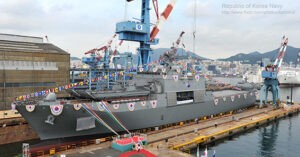
An official aircraft carrier procurement programme was launched in 2020. The project, initially known as the CVX programme, envisages a ship of around 30,000 tonnes that could carry up to twenty F-35B STO/VL fighter jets. The South Korean procurement office is expected to initiate the design phase in 2022 to enable delivery of the type ship in 2033. In the long term, the aim is to acquire up to three units. DSME and HHI are competing for the development contract. Both companies have secured foreign partners with relevant experience: DSME is cooperating with the Italian shipyard Fincantieri, which has already built the aircraft carrier Cavour and the helicopter carrier Trieste, while HHI is receiving support from the British company Babcock, which successfully delivered the two Queen Elizabeth-class carriers.
The introduction of an aircraft carrier will significantly expand the power projection potential of the South Korean navy. In combination with destroyers, frigates and submarines, operations far from the Korean peninsula will be possible. Interoperability with similarly equipped partner forces and the ability to contribute to multinational out-of-area operations will also increase.
Nuclear submarines in sight?
Finally, there is speculation about the development of nuclear-powered fighter submarines. Such ambitions have existed for two decades. The latest rumours were prompted by the construction of a 70 megawatt civilian research reactor announced in November 2021, the design of which would in principle also be suitable for powering a submarine. In November, the Ministry of Research expressly denied that the reactor would be used for military purposes. However, the Ministry of Defence has left open the question of whether the third tranche of KSS-III hunter submarines will be equipped with lithium-ion batteries or nuclear propulsion. Kim Hyun-chong, deputy security adviser to then President Moon Jae-in, even explicitly stated in 2020 that the country's next submarine class would be nuclear-powered. A moderately enlarged version of the KSS-III design could serve as the basis for such further development.
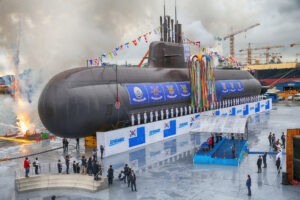
From an operational perspective, nuclear-powered fighter submarines equipped with conventional weapons would primarily increase the ability to defend against North Korean submarines. Although the latter are currently still diesel-electric, they are capable of launching nuclear missiles. In January 2022, Pyongyang also announced its intention to introduce a nuclear propulsion system. This will give the communist state the ability to threaten its southern neighbour from all directions, not just from the north. Due to their operational endurance and top speed, nuclear-powered South Korean fighter submarines would be best suited to detect, shadow and intercept enemy boats in the event of war.
However, it is uncertain whether the government of the newly elected President Yoon will continue the policy of the previous government. During the election campaign at the end of 2021, Yoon declared that South Korea does not currently need nuclear-powered submarines. In doing so, he is likely trying to avoid differences with the USA. Washington continues to insist on compliance with a seven-decade-old agreement that prohibits any military use of nuclear technology by South Korea and has repeatedly rejected Seoul's initiatives to amend this agreement in recent years.
Sidney E. Dean

